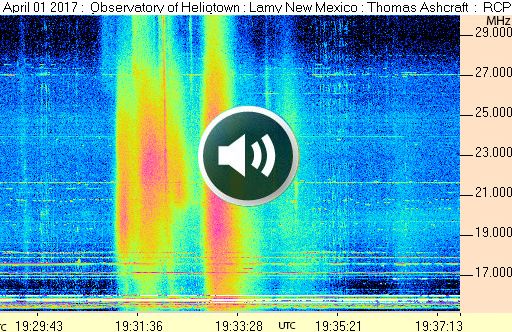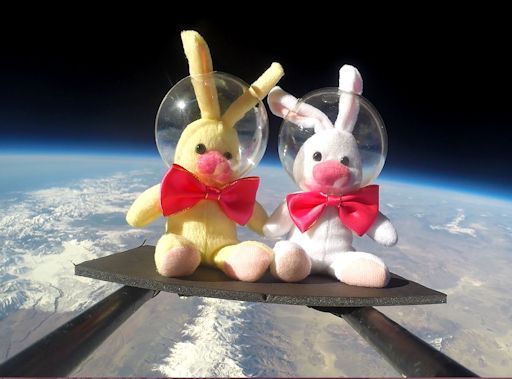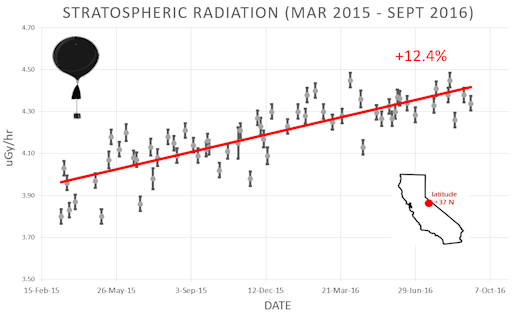Directly under the Arctic Circle! Marianne's Arctic Xpress in Tromsø offers fjord, whale and wildlife tours by day, aurora tours by night. Email Marianne for bookings and availability. | | | CHANCE OF FLARES: NOAA forecasters estimate a 60% chance of M-class solar flares and a 20% chance of X-flares on April 3rd as sunspot AR2644 continues to crackle with magnetic explosions. Extreme UV radiation from such flares can cause shortwave radio blackouts and other disturbances to the normal transmission of radio signals around the globe. Free: Solar Flare Alerts THE SUN WAKES UP: Suddenly, solar flare activity is high. With little warning, sunspot AR2644 exploded on April 1st, producing an M4.4-class flare. That was the strongest solar flare of the year--for less than a day. The sunspot topped itself on April 2nd with a pair of M5-class explosions, followed by another M5-flare on April 3rd. The latest blast is shown here in a picture from NASA's Solar Dynamics Observatory: 
Flashes of extreme ultraviolet radiation, like the one shown above, have been ionizing Earth's upper atmosphere and altering the normal propagation of radio waves around our planet. There have been at least four significant shortwave radio blackouts; blackout maps: #1, #2, #3, #4. People who might have noticed these blackouts include ham radio operators and mariners using low-frequency rigs for communication at frequencies below 10 MHz. Update: This series of explosions hurled a number of coronal mass ejections (CMEs) into space. NOAA computer models confirm that none of them will hit Earth. Realtime Space Weather Photo Gallery SOLAR RADIO BURSTS: Yesterday's M4.4 solar flare from sunspot AR2644 flare caused a shortwave radio blackout. It also produced the opposite--a loud burst of radio static. In rural New Mexico, amateur radio astronomer Thomas Ashcraft recorded the hiss and crackle emerging from the loudspeaker of his receiver. Click to listen: 
"The solar flare generated very strong emissions and nearly saturated my radio telescope," says Ashcraft. " The sound file was recorded at 21 MHz and it has three peaks." Solar radio bursts are caused by solar flares. Electrons accelerated by strong flares race through the sun's atmosphere, causing a ripple of plasma waves and radio static. Astronomers classify solar radio bursts into five types; Ashcraft's recording captured a mixture of Type III and Type V. "I had been thinking that I might not be receiving any more strong solar storms this cycle," says Ashcraft, "but am thrilled to receive this activity. And there might be more to come if AR2644 continues to flare." Realtime Space Weather Photo Gallery
FLIGHT OF THE EASTERNAUTS: Looking for an Easter gift for a young scientist? Submitted for your consideration: The Easternauts. On March 2nd, the students of Earth to Sky Calculus flew a payload-full of Easter bunnies to the edge of space--and you can have one for $39.95. (Space helmet included!) 
Carried aloft by a giant helium balloon, these plush bunnies went on a hare-raising journey more than 113,000 feet above Earth's surface. They encountered temperatures as low as -63 C and cosmic ray dose rates more than 100 times Earth normal. Each bunny comes with a greeting card showing the Easternaut in flight and telling the story of its journey to the stratosphere and back again. More far-out gifts may be found in the Earth to Sky store. All proceeds support STEM education and our atmospheric cosmic ray monitoring program.
Realtime Aurora Photo Gallery
Realtime Comet Photo Gallery
Every night, a network of NASA all-sky cameras scans the skies above the United States for meteoritic fireballs. Automated software maintained by NASA's Meteoroid Environment Office calculates their orbits, velocity, penetration depth in Earth's atmosphere and many other characteristics. Daily results are presented here on Spaceweather.com. On Apr. 3, 2017, the network reported 7 fireballs.
(7 sporadics)  In this diagram of the inner solar system, all of the fireball orbits intersect at a single point--Earth. The orbits are color-coded by velocity, from slow (red) to fast (blue). [Larger image] [movies] Potentially Hazardous Asteroids ( PHAs) are space rocks larger than approximately 100m that can come closer to Earth than 0.05 AU. None of the known PHAs is on a collision course with our planet, although astronomers are finding new ones all the time. On April 3, 2017 there were potentially hazardous asteroids. Notes: LD means "Lunar Distance." 1 LD = 384,401 km, the distance between Earth and the Moon. 1 LD also equals 0.00256 AU. MAG is the visual magnitude of the asteroid on the date of closest approach. | | Cosmic Rays in the Atmosphere |
Readers, thank you for your patience while we continue to develop this new section of Spaceweather.com. We've been working to streamline our data reduction, allowing us to post results from balloon flights much more rapidly, and we have developed a new data product, shown here: 
This plot displays radiation measurements not only in the stratosphere, but also at aviation altitudes. Dose rates are expessed as multiples of sea level. For instance, we see that boarding a plane that flies at 25,000 feet exposes passengers to dose rates ~10x higher than sea level. At 40,000 feet, the multiplier is closer to 50x. These measurements are made by our usual cosmic ray payload as it passes through aviation altitudes en route to the stratosphere over California. What is this all about? Approximately once a week, Spaceweather.com and the students of Earth to Sky Calculus fly space weather balloons to the stratosphere over California. These balloons are equipped with radiation sensors that detect cosmic rays, a surprisingly "down to Earth" form of space weather. Cosmic rays can seed clouds, trigger lightning, and penetrate commercial airplanes. Furthermore, there are studies ( #1, #2, #3, #4) linking cosmic rays with cardiac arrhythmias and sudden cardiac death in the general population. Our latest measurements show that cosmic rays are intensifying, with an increase of more than 12% since 2015: 
Why are cosmic rays intensifying? The main reason is the sun. Solar storm clouds such as coronal mass ejections (CMEs) sweep aside cosmic rays when they pass by Earth. During Solar Maximum, CMEs are abundant and cosmic rays are held at bay. Now, however, the solar cycle is swinging toward Solar Minimum, allowing cosmic rays to return. Another reason could be the weakening of Earth's magnetic field, which helps protect us from deep-space radiation. The radiation sensors onboard our helium balloons detect X-rays and gamma-rays in the energy range 10 keV to 20 MeV. These energies span the range of medical X-ray machines and airport security scanners. The data points in the graph above correspond to the peak of the Reneger-Pfotzer maximum, which lies about 67,000 feet above central California. When cosmic rays crash into Earth's atmosphere, they produce a spray of secondary particles that is most intense at the entrance to the stratosphere. Physicists Eric Reneger and Georg Pfotzer discovered the maximum using balloons in the 1930s and it is what we are measuring today. | | The official U.S. government space weather bureau | | | The first place to look for information about sundogs, pillars, rainbows and related phenomena. | | | Researchers call it a "Hubble for the sun." SDO is the most advanced solar observatory ever. | | | 3D views of the sun from NASA's Solar and Terrestrial Relations Observatory | | | Realtime and archival images of the Sun from SOHO. | | | from the NOAA Space Environment Center | | | a proud supporter of science education and Spaceweather.com | | | fun to read, but should be taken with a grain of salt! Forecasts looking ahead more than a few days are often wrong. | | | from the NOAA Space Environment Center | | | the underlying science of space weather |  | Beautyz for top beauty products reviews and their buying guides |  | Reviews here can help you to pick up best memory foam mattresses. | | | These links help Spaceweather.com stay online. Thank you to our supporters! | | 
